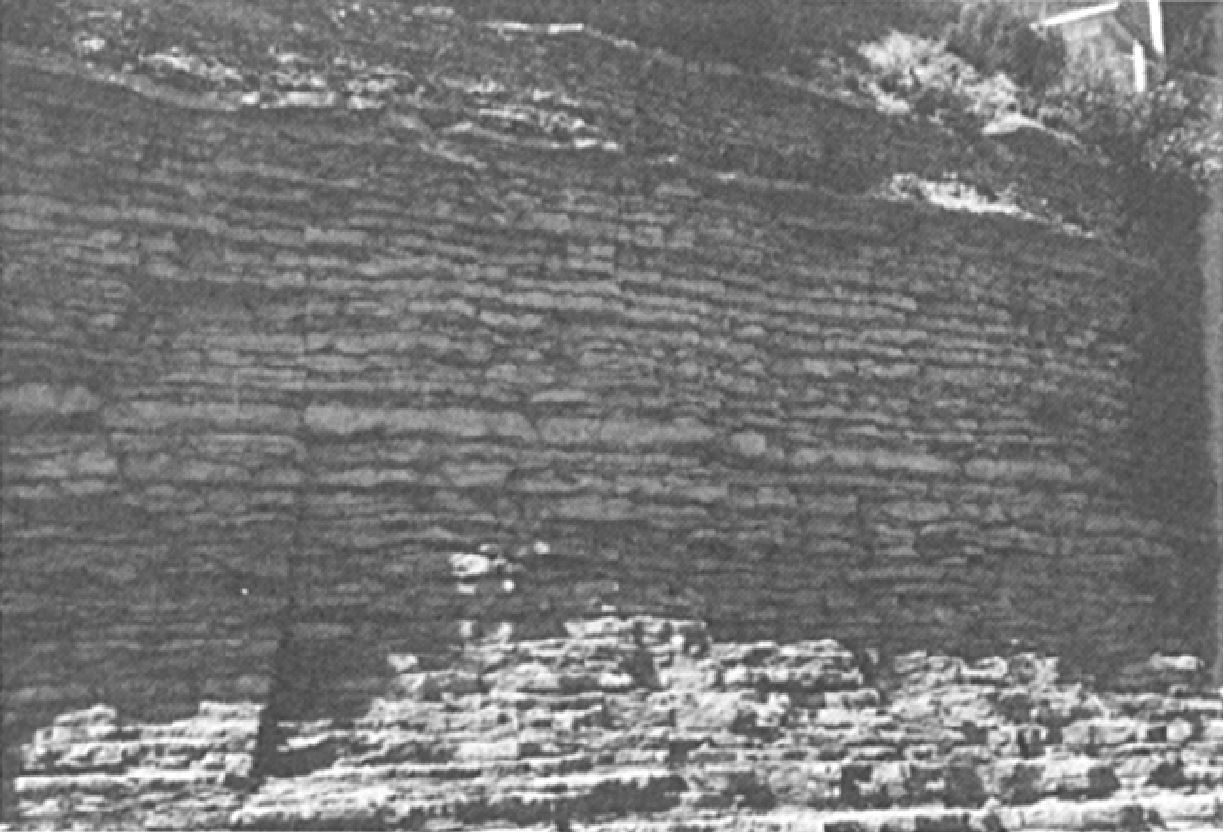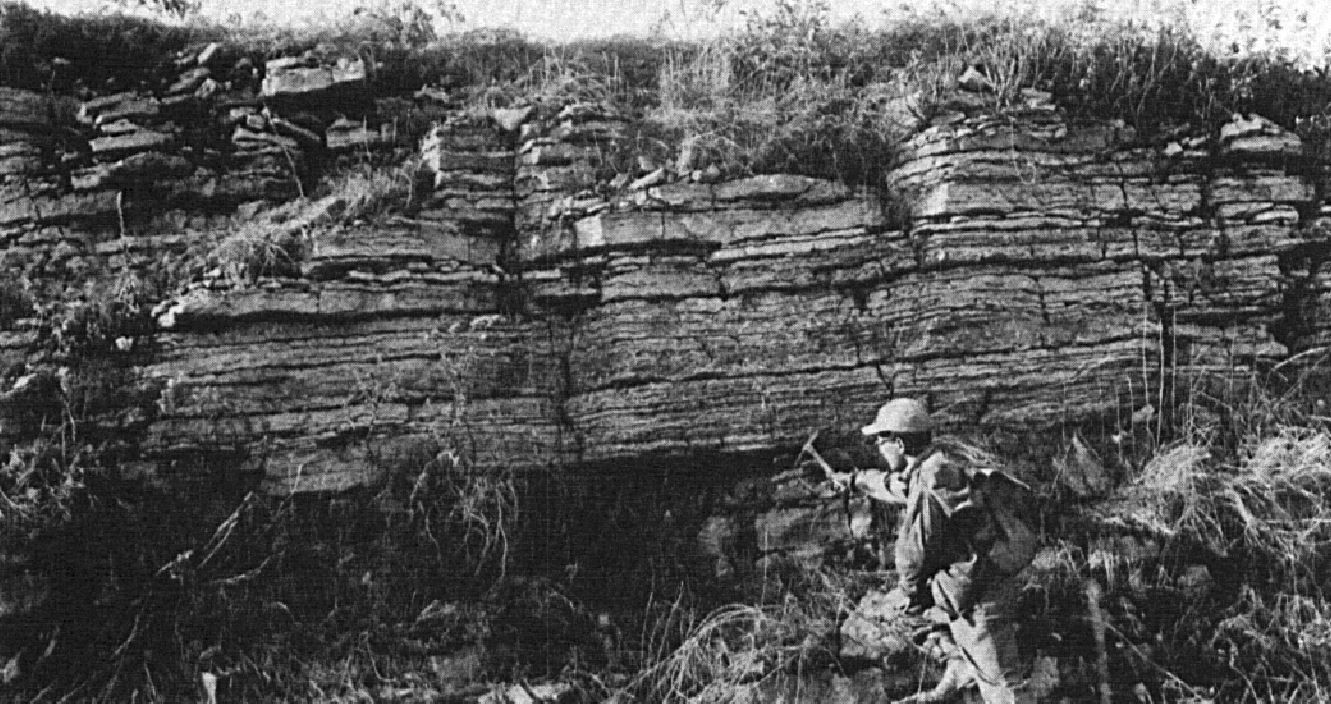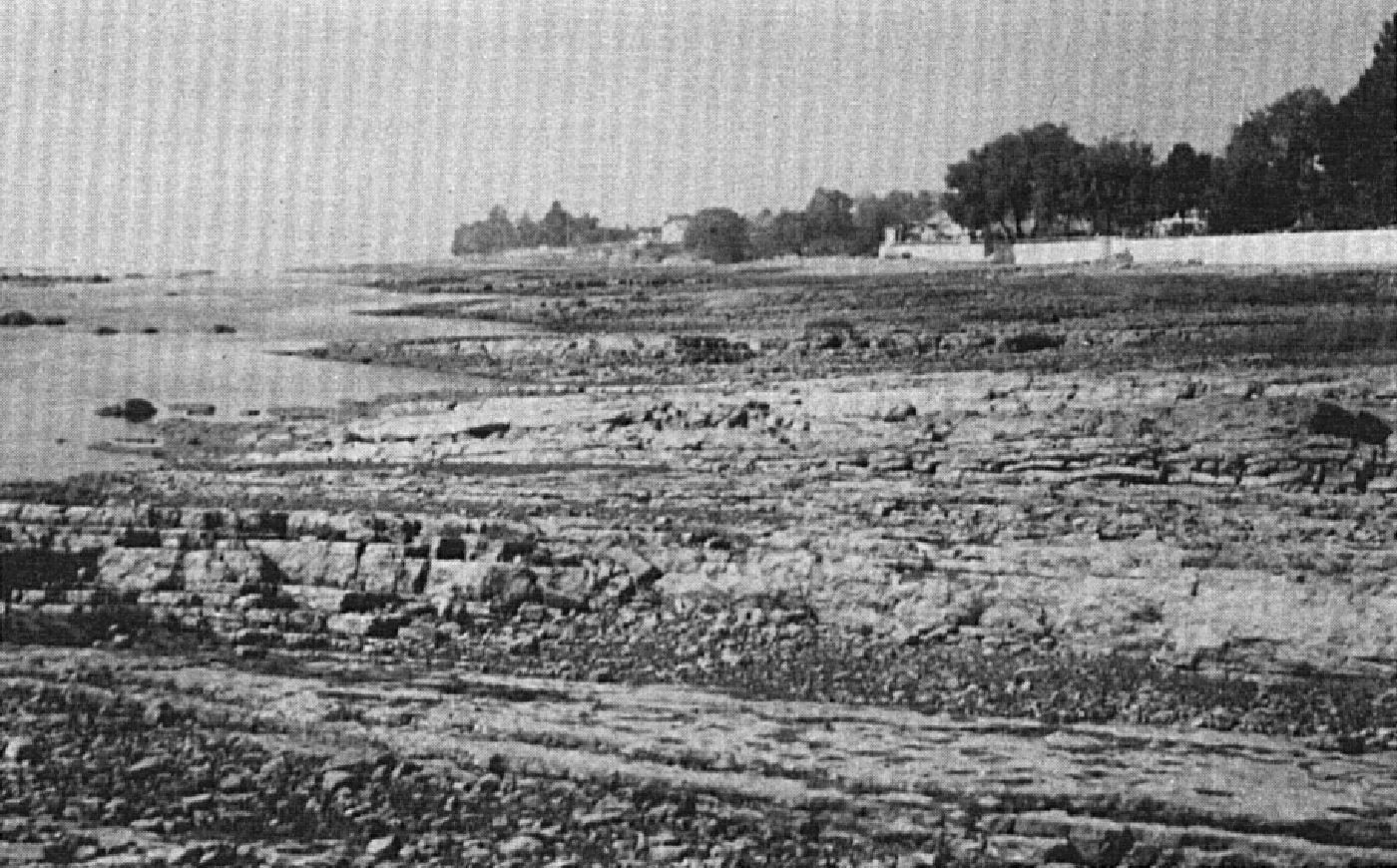
DISCLAIMER: This English version is translated from the original French. In case of any discrepancy, the French version shall prevail.
| Author: | Clark, 1959 |
| Age: | Middle Ordovician |
| Stratotype: | Sections (1) of the Saint-Casimir Member and upper beds of the Deschambault Formation along the railway, 2.4 km NE of the Neuville wharf, and (2) of the Grondines and Saint-Casimir members along the shore of the St. Lawrence River upstream and downstream of the Neuville wharf (base of section 520 m east of wharf) described by Clark and Globensky (1973) |
| Type area: | Neuville area (NTS sheet 21L12) |
| Geological province: | St. Lawrence Platform |
| Geological subdivision: | St. Lawrence Lowlands Platform |
| Lithology: | Black limestone with argillaceous joints, bentonite |
| Category: | Lithostratigraphic |
| Rank: | Formation |
| Status: | Formal |
| Use: | Active |
- Trenton Group
- Tétreauville Formation
- Montréal Formation
- Neuville Formation
- Deschambault Formation
- Hull Formation
- Saint-Marc Formation
- Mile End Formation
- Ouareau Formation
- Fontaine Formation
- Pont-Rouge Formation
- Sainte-Anne Formation
- Galets Formation
- Shipshaw Formation
- Simard Formation
- Tremblay Formation
- René-Levasseur Formation
Background
Clark (1959) introduced the names “Neuville” and “Saint-Casimir” to define a section of the Trenton Group overlying the Deschambault Formation in the Neuville area (sheet 21L12). Thus presented, the “Saint-Casimir Formation” was overlying the Deschambault Formation and was overlain by the Neuville Formation. He suggested that, in the event of a division of the Neuville Formation, this term be kept for the Mid Trenton Group and that the term “Grondines” applies to the Upper Trenton Group. Clark and Globensky (1973, 1975, 1976) used the term “Neuville Formation” to define the lithology between the Deschambault Formation and the Utica Shale, and divided this formation into the Saint-Casimir Member (lower) and Grondines Member (upper). In a revision of the Neuville Formation, Globensky and Jauffred (1971) lowered the contact between the Saint-Casimir and Grondines members by 21 m at the type section along the St. Lawrence River. The name refers to the town of Neuville, where type sections were defined (Clark and Globensky, 1973).
Description
The Neuville Formation consists of 1-15 cm limestone beds separated by thin shale beds (Clark and Globensky, 1973; Globensky, 1993). Limestone, generally compact, is semi-lithographic in the lower part, with only a few crystalline beds. The formation as a whole is not rich in fossils, but some beds contain many fossils, particularly trilobites and brachiopods. The formation is divided into: (a) the Saint-Casimir Member at the base, and (b) the Grondines Member at the top. The former is characterized by a higher percentage of semi-lithographic limestone and the latter by a higher percentage of shale interbeds.
Two sections were described by Clark and Globensky (1973): a section of the Saint-Casimir Member and upper beds of the Deschambault Formation along the railway, 2.4 km NE of the Neuville wharf, and a section of the Grondines and Saint-Saint-Casimir members along the shore of the St. Lawrence River upstream and downstream of the Neuville wharf, whose base is located 520 m east of the wharf.
| Neuville Formation | Grondines Member | Top of the Grondines Member. | 111.2 m |
| Limestone made undulating by weathering. Abundant cephalopod fragments. | 111.2 m | ||
| Cherty limestone, frequent argillaceous partings. | 111.0 m | ||
| Dark argillaceous limestone in 5-10 cm beds with argillaceous partings 2.5 cm thick. | 101.2 m | ||
| Idem, but with argillaceous partings 2.5-7.5 cm thick. | 95.1 m | ||
| Lithographic limestone; sparse in the upper part of the section. | 90.6 m | ||
| Dark argillaceous limestone in 5-10 cm beds with argillaceous partings 2.5 cm thick. | 90.4 m | ||
| Nodular limestone in beds up to 5 cm. | 86.6 m | ||
| Crystalline limestone, coarse-grained, light grey. | 85.4 m | ||
| Nodular crystalline limestone, dark, thin and thick-bedded. | 85.3 m | ||
| Impure limestone, with a very irregular alteration surface. Rafinesquina deltoidea is frequent. | 84.1 m | ||
| Chemical limestone, pure, in 2.5-3.8 cm beds. | 79.7 m | ||
| Impure limestone in beds 5-15 cm thick. | 79.5 m | ||
| Dark limestone, with an irregular alteration surface. | 78.0 m | ||
| Thick-bedded limestone, up to 20 cm, with poorly defined argillaceous schist joints. | 77.3 m | ||
| Argillaceous limestone with thin argillaceous schist beds. Pure limestone beds are sparse. Large flat surfaces with the diving raft are at the top of this thickness. | 75.3 m | ||
| Mainly chemical limestone, with impure and nodular limestone forming a small cliff that contains a 53.3 cm thick bed. | 70.6 m | ||
| Mainly chemical limestone forming an uniform surafce in front of the hotel. | 68.0 m | ||
| Thin and thick-bedded limestone with argillaceous partings up to 7.5 cm thick. Beds become thinner towards the top and argillaceous partings less frequent. Numerous holes, Rafinesquina deltoides and R. alternata very frequent in a few beds. No type of pure chemical or crystalline limestone was observed. This sequence forms a 4.8 m high cliff. | 65.2 m | ||
| Limestone outcropping mostly as thin beds on the shore. | 60.4 m | ||
| Brecciated bed. Beds above and below are not affected. | 53.2 m | ||
| Almost pure limestone with thin argillaceous partings. At the top of this thickness is a large area dipping westward. | 52.9 m | ||
| Impure crystalline limestone, argillaceous with flaky alteration. | 50.9 m | ||
| Almost pure chemical limestone with some argillaceous partings. | 49.5 m | ||
| Dark grey lithographic limestone. | 46.5 m | ||
| Impure limestone in beds 5-7.5 cm thick with argillaceous partings 5 cm thick, brownish alteration. | 46.3 m | ||
| Cherty limestone, shattering fractures. | 43.0 m | ||
| Cherty limestone in beds 5-7.5 cm thick; one 15 cm thick bed of argillaceous schist. | 42.1 m | ||
| Impure limestone, with argillaceous partings 2.5-5 cm thick. | 40.8 m | ||
| Impure limestone, nodular, dark, fine-grained, in beds 5 cm thick. Highly fossiliferous. Well exposed at the top of the shore at low tide. Less visible when swept by tide. Cryptolithus triplecia nuclea are Ceraurus pleurexanthèmus lorettenesis are particularly abundant. | 39.7 m | ||
| Limestone in 15 cm thick beds. Nodular appearence probably caused by original deposition. | 38.9 m | ||
| Almost lithographic limestone in beds 5-7.5 cm thick with argillaceous partings 2.5-5 cm thick. | 37.9 m | ||
| Schistose limestone containing Cryptolithus. Base of the Cryptolithus lorettensis zone of the Grondines Member. | 36.8 m | ||
| Missing. | 36.5 m | ||
| Fine-grained grey limestone, thin-bedded. | 36.2 m | ||
| Fossiliferous limestone, crystalline, coarse-grained, grey, thick-bedded. | 35.4 m | ||
| Missing. | 35.1 m | ||
| Crystalline limeatone, nodular, dark grey. | 34.1 m | ||
| Missing. | 33.1 m | ||
| Bownish lithographic limestone with very thin argillaceous partings. Here and there, thin beds of crystalline and fossiliferous limestone. | 32.6 m | ||
| Base of the section west of wharf. Top of section east of wharf. | 26.8 m | ||
| Grey to dark grey chemical limestone. | 26.8 m | ||
| Schistose limestone forming thick (15 cm) and thin (5 cm) beds with argillaceous partings. Lithographic limestone beds are present. | 25.5 m | ||
| Dark crystalline and argillaceous limestone. | 23.9 m | ||
| Idem with interstratified fine-grained lithographic limestone. | 23.2 m | ||
| Thick bed of fine-grained limestone. | 21.0 m | ||
| Thin-bedded limestone, highly altered. | 18.3 m | ||
| Thick-bedded limestone. | 15.8 m | ||
| Brown limestone and argillaceous schist, interstratified in beds 5-20 cm thick. | 12.5 m | ||
| Saint-Casimir Member | Crystalline limestone, fine-grained, dark grey, small amount of brownish limestone. | 11.9 m | |
| Impure limestone, crystalline, fine-grained, dark grey. | 9.8 m | ||
| Almost lithographic limestone with a few crystalline limestone beds 1.3 cm thick. | 9.2 m | ||
| Crystalline limestone, very fine-grained, dark, with a few lithographic limestone beds. | 7.1 m | ||
| Lithographic limestone with a few argillaceous partings. | 4.4 m | ||
| Crystalline limestone, fine-grained, dark. | 3.8 m | ||
| Base of the section measured, 518 m eat of the Neuville wharf. | 0.0 m | ||
| Neuville Formation | Saint-Casimir Member | Top. SW end of the railway trench. | 27.7 |
| Almost lithographic limestone, very fine-grained, altered cream colour, very finely bedded and, in places, cross-bedded. Frequent argillaceous partings. Individual beds are rarely thicker than 10 cm. In the following descriptions, this type will be refferd by the letter “Y”. | 27.7 | ||
| Crystalline limestone interstratified with Y. Abundant crinoids and other fossile. Giant Isotelus and translucent stems, frequent on the shore of Neuville, are present here. | 26.4 | ||
| Y, with argillaceous partings. | 26.1 | ||
| Y, interstratified with a crystalline rock containing fragments. Minor unconformities are prsent almost every 2.5 cm. | 22.9 | ||
| Crystalline limestone, containing fragments, fine-grained, irregularly bedded, interstratified with Y. Above this horizon, Y predominates. | 21.0 | ||
| Y | 20.2 | ||
| Light and dark limestone with irregular bedding, with 2.5 cm of Y. | 20.0 | ||
| Crystalline limestone, medium to fine-grained, in beds 2.5-5 cm thick with argillaceous partings 0.6-1.3 cm thick. One Y bed 2.5 cm thick. | 19.5 | ||
| Various types of limestone, with irregular bedding. | 17.4 | ||
| Crystalline limestone containing fragments, interstratified with a smaller amount of Y, the latter never exceeding 15 cm in thickness. | 16.8 | ||
| Fine-grained argillaceous limestone, in beds 2.5-5 cm thick. | 13.3 | ||
| Coarse-grained crystalline limestone, cross-bedded. Prasopora and crinoids at 12.2 m. | 12.8 | ||
| Interstratified crystalline limestone and Y. | 11.4 | ||
| Finely and uniformly bedded limestone, interstratified with medium-grained crystalline limestone. | 9.6 | ||
| Medium and coarse-grained limestone with cross-bedding. | 9.4 | ||
| Y, at its lowest position. | 7.3 | ||
| Deschambault Formation | Fine, medium and coarse-grained crystalline limestone with cross-bedding. | 7.2 | |
| Very fine-grained limestone. | 3.7 | ||
| Very coarse-grained crystalline limestone with cross-bedding. Prasopora and Rafinesquina very frequent. | 3.6 | ||
| Fine-grained limestone, very finely bedded, in beds up to 2.5 cm thick. | 3.2 | ||
| Coarse and fine-grained crystalline limestone. Prasopora frequent. | 2.7 | ||
| Base of the section. | 0.0 |
Sediments of the Neuville Formation were deposited in a low-energy environment, on a continental shelf increasing in depth to sea, and were accumulated mainly by suspension (Harland and Pickerill, 1982). In the Baie-Saint-Paul and La Malbaie area (sheets 21M07 to 21M09), the Neuville Formation consists almost entirely of grey to dark grey micritic limestone with regular bedding, massive or parallel laminations (Harland and Pickerill, 1982). The major difference observed for the Neuville Formation in this area is the presence of numerous beds deformed by slippage and fall, suggesting greater instabilities and subsidence in the deposition environment.
Thickness and distribution
The Neuville Formation can be observed north of the St. Lawrence River, almost continuously from Trois-Rivières (sheets 31I06-31I07) to Beaupré (sheet 21L14). Its thickness varies from 87 to 187 m, with the maximum being in the Trois-Rivières area (Clark and Globensky, 1973, 1975; Globensky, 1993). The formation is also present in the Baie-Saint-Paul and La Malbaie areas, where it outcrops intermittently along streams (sheets 21M07 to 21M10).
Dating
None.
Stratigraphic Relationship(s)
The Neuville Formation is the upper unit of the Trenton Group in the Trois-Rivières, Portneuf and Quebec City areas, and overlies the Deschambault Formation. The presence of Cryptolithus lorettensis and Rafinesquina deltoidea at the base of the Grondines Member indicates that the latter was completely deposited during the Cobourg and can be correlated with the Tétreauville Formation in the greater Montreal area (Globensky, 1987, 1993). The underlying Saint-Casimir Member is thus Sherman Fall in age and can be correlated with the Saint-Michel Member of the Montréal Formation (Clark and Globensky, 1973, 1976; Harland and Pickerill, 1982; Globensky, 1987).
Paleontology
The most significant fossils are Rafinesquina deltoidea and Cryptolithus lorettensis (Globensky, 1993). Other fossils are abundant and can be seen along the shore of Neuville: Prasopora orientales, Isotelus gigas, Ceraurus pleurexanthemus, Sowerbyelia sericea, Paucicrura rogata. In addition, Globensky and Jauffred (1971) identified four conodont assemblages: 1) Phragmodus undatus assemblage; 2) Panderodus graciais assemblage; 3) Panodus suberectus assemblage; and 4) Periodon grandis assemblage.
References
Publications Available Through SIGÉOM Examine
BILODEAU, C., BRUN, J. 2000a. GEOLOGIE 1/20 000, 21L12-200-0101 – SAINT-ÉDOUARD. In : MRNF. 2010. CARTE(S) GÉOLOGIQUE(S) DU SIGEOM – feuillet 21l. CG SIGEOM21L, 43 plans.
BILODEAU, C., BRUN, J. 2000b. GEOLOGIE 1/20 000, 21L12-200-0201 – PORTNEUF. In : MRNF. 2010. CARTE(S) GÉOLOGIQUE(S) DU SIGEOM – feuillet 21l. CG SIGEOM21L, 43 plans.
BILODEAU, C., BRUN, J. 2000c. GEOLOGIE 1/20 000, 21L12-200-0202 – DONNACONA. In : MRNF. 2010. CARTE(S) GÉOLOGIQUE(S) DU SIGEOM – feuillet 21l. CG SIGEOM21L, 43 plans.
BILODEAU, C., BRUN, J. 2001. GEOLOGIE 1/50 000, 21L13 – SAINT-RAYMOND. In : MRNF. 2010. CARTE(S) GÉOLOGIQUE(S) DU SIGEOM – feuillet 21l. CG SIGEOM21L, 43 plans.
BRUN, J. 1974. ETUDE PETROGRAPHIQUE DES FORMATIONS DU BLACK RIVER ET DU TRENTON DU QUEBEC. MRN. DP 248, 24 pages and 4 plans.
BRUN, J. 1975. ETUDE GEOLOGIQUE ET GEOCHIMIQUE DES FORMATIONS DU BLACK RIVER ET DU TRENTON DU QUEBEC. MRN. DP 296, 45 pages and 4 plans.
CLARK, T H., GLOBENSKY, Y. 1973. PORTNEUF AND PARTS OF SAINT-RAYMOND AND LYSTER MAPS ARES, PORTNEUF AND LOTBINIERE COUNTIES. MRN. RG 148(A), 112 pages et 1 plan.
CLARK, T H., GLOBENSKY, Y. 1973. REGION DE PORTNEUF ET PARTIES DE ST-RAYMOND ET DE LYSTER, COMTES DE PORTNEUF ET DE LOTBINIERE. MRN. RG 148, 117 pages and 1 plan.
CLARK, T H., GLOBENSKY, Y. 1975. REGION DE GRONDINES. MRN. RG 154, 171 pages and 1 plan.
CLARK, T H., GLOBENSKY, Y. 1976. REGION DE TROIS-RIVIERES. MRN. RG 164, 94 pages and 1 plan.
GLOBENSKY, Y. 1987. GEOLOGIE DES BASSES-TERRES DU SAINT-LAURENT. MRN. MM 85-02, 71 pages and 1 plan.
GLOBENSKY, Y. 1993. LEXIQUE STRATIGRAPHIQUE CANADIEN – VOLUME V-B – REGION DES APPALACHES, DES BASSES-TERRES DU SAINT-LAURENT ET DES ILES DE LA MADELEINE. MRN. DV 91-23, 336 pages.
HÉBERT, C., BILODEAU, C. 1999a. GEOLOGIE 1/20 000, 21M07-200-0202 – BAIE-SAINT-PAUL. In : MRNF. 2010. CARTE(S) GÉOLOGIQUE(S) DU SIGEOM – feuillet 21m. CG SIGEOM21M, 23 plans.
HÉBERT, C., BILODEAU, C. 1999b. GEOLOGIE 1/20 000, 21M09-200-0101 – SAINT-HILARION. In : MRNF. 2010. CARTE(S) GÉOLOGIQUE(S) DU SIGEOM – feuillet 21m. CG SIGEOM21M, 23 plans.
HÉBERT, C., BILODEAU, C. 1999c. GEOLOGIE 1/20 000, 21M09-200-0102 – SAINT-IRENEE. In : MRNF. 2010. CARTE(S) GÉOLOGIQUE(S) DU SIGEOM – feuillet 21m. CG SIGEOM21M, 23 plans.
HÉBERT, C., BILODEAU, C. 1999d. GEOLOGIE 1/20 000, 21M09-200-0201 – NOTRE-DAME-DES-MONTS. In : MRNF. 2010. CARTE(S) GÉOLOGIQUE(S) DU SIGEOM – feuillet 21m. CG SIGEOM21M, 23 plans.
HÉBERT, C., BILODEAU, C. 1999e. GEOLOGIE 1/20 000, 21M09-200-0202 – LA MALBAIE. In : MRNF. 2010. CARTE(S) GÉOLOGIQUE(S) DU SIGEOM – feuillet 21m. CG SIGEOM21M, 23 plans.
LACOSTE, P., HÉBERT, C., BILODEAU, C. 1999. GEOLOGIE 1/50 000, 21M08 – ILES AUX COUDRES. In : MRNF. 2010. CARTE(S) GÉOLOGIQUE(S) DU SIGEOM – feuillet 21m. CG SIGEOM21M, 23 plans.
MRNF 2009a. GEOLOGIE 1/50 000, 31I02 – YAMASKA. In : MRNF. 2010. CARTE(S) GÉOLOGIQUE(S) DU SIGEOM – feuillet 31i. CG SIGEOM31M, 16 plans.
MRNF 2009bb. GEOLOGIE 1/50 000, 31I07 – TROIS-RIVIÈRES. In : MRNF. 2010. CARTE(S) GÉOLOGIQUE(S) DU SIGEOM – feuillet 31i. CG SIGEOM31M, 16 plans.
MRNF 2009c. GEOLOGIE 1/50 000, 31I08 – BÉCANCOUR. In : MRNF. 2010. CARTE(S) GÉOLOGIQUE(S) DU SIGEOM – feuillet 31i. CG SIGEOM31M, 16 plans.
MRNF 2009d. GEOLOGIE 1/50 000, 31I09 – GRONDINES. In : MRNF. 2010. CARTE(S) GÉOLOGIQUE(S) DU SIGEOM – feuillet 31i. CG SIGEOM31M, 16 plans.
Other Publications
CLARK, T.H. 1959. Stratigraphy of the Trenton Group, St. Lawrence Lowlands, Quebec. Geological Association of Canada; proceedings 1959, pages 13-21.
GLOBENSKY, Y., JAUFFRED, J.C.N. 1971. Stratigraphic distribution of conodonts in the Middle Ordovician Neuville section of Quebec. Geological Association of Canada, proceedings; volume 23, pages 43-68.
HARLAND, T.L., PICKERILL, R.K. 1982. A review of Middle Ordovician sedimentation in the St. Lawrence Lowland, eastern Canada. Geological Journal; volume 17, pages 135-156. https://doi.org/10.1002/gj.3350170205




